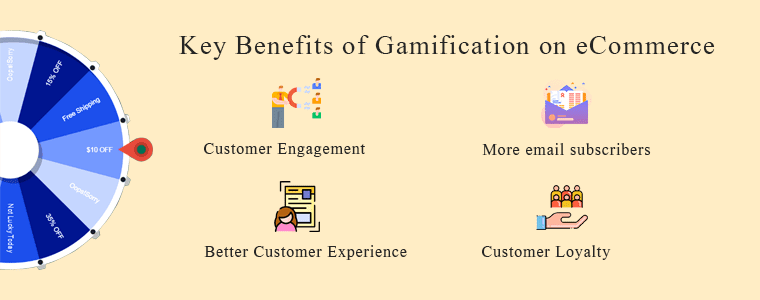Gamification marketing is everywhere – from interactive doodles on the Google homepage to Buzzfeed trivia to various mini-games, spinning wheels, and digital slots on Amazon. Recent years of lockdown have increased our dependence on e-commerce sites, and with general customer interest waning every year, gamification and its added immersion and interaction have become the need of the hour for these business owners.
In e-commerce, gamification indicates assimilating and deploying strategies akin to gameplay methods in video games to boost sales in digital stores – either digital assets or physical items.
Ways to Gamify Your Ecommerce Business:
As a market leader, here are a couple of ways you can harness the power of gamification in your e-commerce business.
- Use games like Scavenger Hunt to ensure that your customers – both existing and new – visit key pages on your e-commerce site. Gamification marketing strategies like these incentivize user interaction and create the initial hook.
- Another good way is to use a Wheel of Fortune with different promo codes and discounts at stake. Not only does this game of chance introduce a sense of thrill among customers, but it also turns casual site-browsers into potential buyers.
- Set up a rewards program. Loyalty points and incentives redeemable via spending those points boost your trustworthiness as a brand. They show users that you care about them – a factor that attracts new customers as well. Vary the rewards into tiers that work like levels of privilege to reap more benefits. Choose the customer behavior that you want to reward – ranging from signing up for your newsletter, sharing in social media, product reviews, etc.
- Fun behavioral quizzes or trivia are another great way to direct your customers to the product that is best suited for them. You can analyze the vital data generated from these gamification marketing methods to further understand your user base and demographic as well as traction levels for products being sold via your e-commerce site.
- Recently, some organizations have also benefited by launching dedicated mini-game apps that tie into their e-commerce sites. These game apps can help promote products available in your store as well as generate awareness about your brand and its message.
- Lastly, make sure your gamified incentivization methods are meaningful. Quite often, users tend to be more loyal to a brand or a site where they can achieve or partake in something bigger than them. A good example of this is Nike’s successful Nike+ campaign – tailored towards covering every aspect of an athlete’s life – including social integration, training, competition, and sports style.

Some recent examples:
- Global beauty brand Sephora has an extensive loyalty program that is the perfect example of a gamification technique applied in e-commerce. Users earn 1 loyalty point per $1 they spend in the store/site and these points can then be used to unlock more privileges (free shipping, deeper discounts, etc.). Moreover, long-time users are also promoted to the next privilege level (VIB, Rouge) with even more rewards.
- Karl Lagerfeld’s online store created a retro-inspired video game similar to the cult classic, Pacman, to promote their Spring 2020 pixel collection. The game featured Karl’s very own cat, Choupette. This online game had users catching as many special KARL bonus items as they could while defeating Choupette’s foes – dogs. Winners were rewarded with a shopping spree at Karl Lagerfeld’s store.
- Nike released an online game in 2011, dubbed ‘Winter’s Angry. Fight Back’ to promote its line of winter sportswear debuting at the end of that year. Players took control of a virtual avatar of one of three very popular athletes – NFL wideout Greg Jennings, USA Women’s soccer player Alex Morgan and Olympic gold medal sprinter Allyson Felix – to perform a series of training exercises to ‘beat the cold’. Players could win prizes for completing challenges, and ones with top scores were eligible for a trip to meet the athletes. Nike’s game website also doubled as a store to purchase apparel featured on these athletes.
- ‘14-Day Blast Off’ from the popular grocery chain Whole Foods encouraged participants to commence on a healthy diet journey at the onset of a new year. Whole Foods cleverly incorporated gamification marketing techniques in this campaign that rewarded users when they completed one or more milestones, in form of rebates on in-store purchases.
- Cityville, the now-defunct social city-building game from Zynga, was a mammoth hit back in the early 2010s when it launched. At its heyday, a staggering 71 million users were playing the game on Facebook. Best Buy took advantage of Cityville’s reach by opening the first branded retail store in-game. Players could place the store in their virtual city, gain game currency and points when they collected electronic items, and even roam the city in Best Buy’s widely popular Geek Squad vehicles. This gamification marketing was a clever way to advertise Best Buy’s store to a wide variety of customers beyond their usual demographic.
- ALDO’s Instagram Moodboard is also a good example of gamification being used in e-commerce. ALDO tied its release of the “A is for Aldo” fragrance collection with Facebook minigames that encouraged users to match their mood with Instagram images. The result was a shareable collage of images associated with any of the three colors and the perfume represented by that color.
—
The global gamification market is projected to reach $32 Billion by 2025. Organizations are being compelled to implement more visually immersive, engaging, interactive ways to attract new users and retain their existing customer base. In the world of e-commerce, the fight is even more fierce. Incorporating gamification techniques can not only make your e-commerce platform stand out from the competition but can also build value and awareness for your brand – assets that are defining factors of success in this fast-moving industry.



